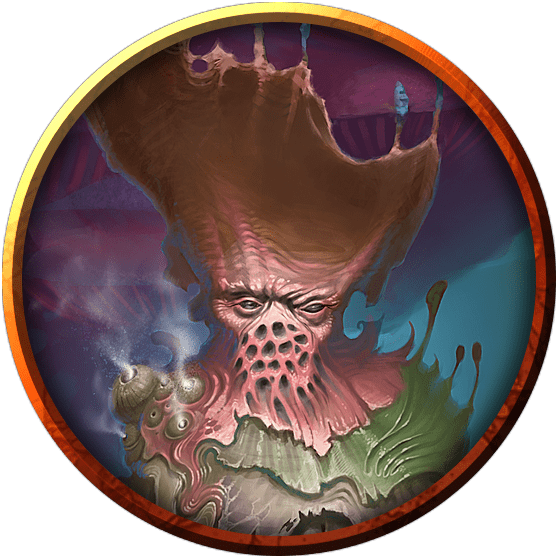Myconid (/ˈmaɪkoʊnɪdz/ MY-ko-nidz)
Myconids, also known as fungus ones, and fungus folk, were a race of ambulatory fungus creatures. They were known for their peacefulness and appreciation of quiet, making their homes in the darker corners of the world.
Basic Information
Biological Traits
Myconids resembled giant fungi ranging from 2-12 feet (.6-3.6 meters) tall, with their main distinguishing feature being their limbs. Their upper half split into a pair of arms below their caps and their lower half divided into a pair of legs at the stump. Each extremity was pudgy and broad, with their hands ending in two stubby fingers and a thumb, and their feet hosting numerous vestigial toes. This number was not absolute however, with some fungus folk hosting more than the usual number of limbs and/or digits. The bloated flesh of most myconids ranged in coloration from purple to gray. Two eyes rested on their caps, perfectly concealed against the rest of their spongy skin when shut. Some fungus ones secreted a poisonous ooze from near everywhere but their hands.
A mutant strain of myconid referred to as venom spores had a pale milky skin tone contrasted by a bright red cap. Their eyes were a sickly shade of yellow with identically colored spots adorning their caps.
Abilities
In terms of offensive physical ability, most myconids were limited to clasping their hands and pummeling their opponents into submission. Many could apply the poisonous effects of their bodies to their fists and inflict noxious pain onto their opponents. Rather than combat efficiency, the primary ability of the fungus folk was access to various specialized spores they were capable of spewing to achieve a wide variety of effects. As myconids grew older they would gain access to a greater number of types and uses of their spores. Distress spores were the first to develop, able to quickly spread hundreds of feet in a matter of seconds and alert other myconids of danger either by choice or in response to pain. Once thought to only come later in life, myconids could also release rapport spores which gave them the ability to telepathically communicate with other intelligent lifeforms. This method of communication lasted up to an hour for nonmyconids but for fungus folk, functioned for a full eight hours. Later would come reproduction spores used to create new myconids and that posed no ill effects to non-myconids. After this stage were pacification spores used by older myconids to daze incoming threats, although venom spores contained a toxic alternative that caused nonmyconids to grow incredibly ill. Hallucination spores came next, primarily used in the melding rituals but that could also incapacitate threats. Finally were animator spores, a type of spore usable solely by a sovereign. These spores would cause a purple, bulbous fungus to grow upon intact corpses, taking over the systems and raising them as spore servants under command of the highest authority myconid present. Animation could last for several weeks, affecting even mostly skeletal corpses until so little flesh was left that the body gave out and disintegrated.[9] So long as the target wasn't too large and was originally composed of flesh and blood, any entity could be animated. Whether through accumulated skill or natural aptitude, fungus folk had a vast array of knowledge about fungi ranging from optimal growing conditions for various types, the amount an area could yield, and what could be made using them. Through a mysterious bond, myconids could also control a wide variety of plant and fungal monsters, including shambling mounds, phantom fungi, assassin vines and roperlike plant monsters. This knowledge of fungi extended to the sovereign, who was capable of using various types in order to perform a special kind of alchemy. While capable of replicating the effects of normal potions, this fungal alchemy was also used to create special effects unlike those of run of the mill alchemical concoctions. If the colony was predicted to need to fight they would create special healing potions that only worked on fungi, as well as a hallucinatory power to be stored in spider silk and used as a trap. In times when the population was too short they could also create potions that caused accelerated aging, as well as an anointment potion that was immediately and painfully cause an old myconid to become a king. The rarest of these special brews to be created was a decay potion, that infected a living being with an alchemical version of animator spores, killing them within 3 minutes.Additional Information
Uses, Products & Exploitation
May care a few coins or trinkets.
May hold a small hoard of collected baubles and such.
A plant-like creature doesn't have any actual meat, but may be composed of edible plants and fungi.
Harvesting



